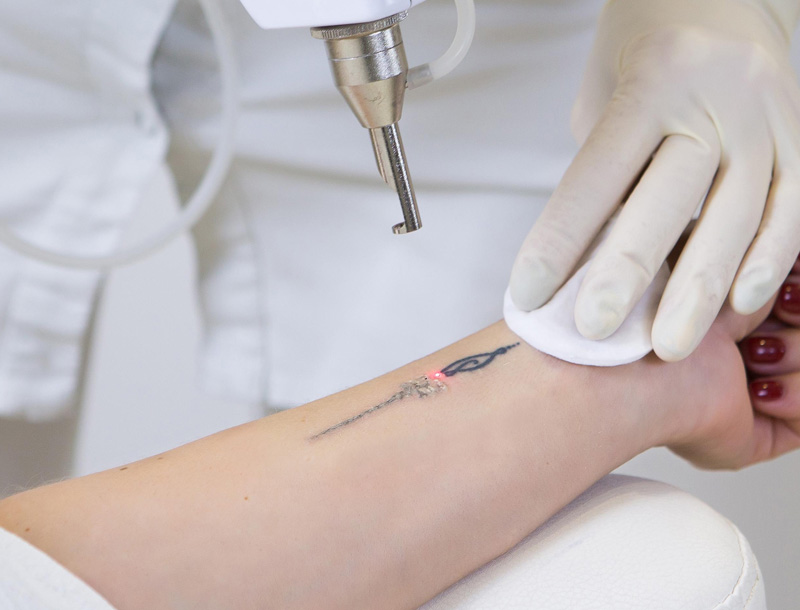Hair Treatment
Skin & Anti-ageing
Tattoo Removal Procedure
Tattoo removal has been performed with various tools since the start of tattooing. While tattoos were once considered permanent, it is now possible to remove them with treatments, fully or partially. Tattoo removal is most commonly performed using lasers that break down the ink particles in the tattoo into smaller particles. Dermal macrophages are part of the immune system, tasked with collecting and digesting cellular debris. In the case of tattoo pigments, macrophages collect ink pigments but have difficulty breaking them down. Instead, they store the ink pigments. If a macrophage is damaged, it releases its captive ink, which is taken up by other macrophages. This can make it particularly difficult to remove tattoos. When treatments break down ink particles into smaller pieces, macrophages can more easily remove them.
Tattoo pigments have specific light absorption spectra. A tattoo laser must be capable of emitting adequate energy within the given absorption spectrum of the pigment to provide an effective treatment. Certain tattoo pigments, such as yellows and fluorescent inks are more challenging to treat than darker blacks and blues because they have absorption spectra that fall outside or on the edge of the emission spectra available in the tattoo removal laser. Recent pastel coloured inks contain high concentrations of titanium dioxide which is highly reflective. Consequently, such inks are difficult to remove since they reflect a significant amount of the incident light energy out of the skin.
Tattoo removal is often done as an outpatient procedure with local anesthesia. Common techniques for tattoo removal include laser surgery, surgical removal, and dermabrasion.
Laser surgery
Q-switched lasers - which release energy in a single, powerful pulse - are often the treatment of choice for tattoo removal. A special type of laser - called a Q-switched Nd:YAG - might be used on darker skin to avoid changing the skin's pigment permanently.
Before laser treatment, the skin is numbed with an injection of a local anesthetic. Then a powerful pulse of energy is applied to the tattoo to heat and shatter the tattoo ink. Multicolored tattoos might need treatment with various lasers and different wavelengths.
After the procedure, you might notice swelling and possibly blistering or bleeding. An antibacterial ointment can help promote healing. You'll likely need repeated sessions to lighten the tattoo, and it might not be possible to completely erase the tattoo.
Surgical removal
During surgical removal, the skin is numbed with an injection of a local anesthetic. The tattoo is removed with a scalpel, and the edges of the skin are stitched back together. After the procedure, antibacterial ointment helps promote healing. Surgical tattoo removal is effective - but it leaves a scar and might be practical only for small tattoos.
Dermabrasion
During dermabrasion, the tattooed area is typically chilled until numb. Then the tattooed skin is sanded down to deeper levels with a high-speed rotary device that has an abrasive wheel or brush. This allows the tattoo ink to leach out of the skin. The affected area feels sore and raw for several days after the procedure. Recovery can take up to two to three weeks. Due to unpredictable results and less effective outcomes than laser or a combination of laser and excision, dermabrasion isn't a common choice.

What Are the Benefits?
There are a number of marked advantages to laser tattoo removal, most of which involve the non-surgical nature of this treatment. These advantages include:
- No scarring - The laser light is designed to leave your healthy skin cells alone. This means that the potential for scarring is low, which contrasts removal methods that rely upon "sanding" the skin.
- Effective fading and removal of tattoos - Laser removal can effectively diminish the appearance of tattoos without the lasting effects that can make other methods of removal undesirable.
- Minimal recovery - After receiving treatments of laser tattoo removal, you need to protect your skin from ultraviolet radiation for a few days. A small amount of redness and tenderness may persist, but these effects should subside within a few days of treatment.
- Removing specific or entire tattoos - Laser tattoo removal can remove specific tattoos or cleanse entire regions of your body from tattoos.
- Safety - Laser tattoo removal is one of the safest ways to remove tattoos. The risk of infection is minimal, few undesirable side effects occur after receiving treatment and comfort tends to stay high during the treatment process.









